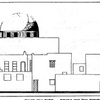Disclaimer
This entry contains information known to us from a variety of sources but may not include all the information currently available. Please be in touch if you notice any inadvertent mistakes in our presentation or have additional knowledge or sources to share. Thank you.
Archive
Dar Bishi Synagogue at Tripoli, Libya
Inside the Dar Bishi Synagogue in Tripoli, Libya, paint peels from the walls and refuse litters the floors. The entrances and most of the windows have been covered with bricks, although the windows high up in the synagogue's dome remain open, letting sunlight in to illuminate the ruined room below. Despite the efforts of Dr. David Gerbi, a Libyan Jew who returned to Tripoli in 2011 after more than 40 years abroad, the synagogue remains closed and empty. However, it has escaped the fate of many of Libya's synagogues, which have been repurposed into other buildings or demolished entirely.1
Description
History and Redesigns Originally built in 1770, the Dar Bishi Synagogue served as a Jewish center for years until it fell into disrepair in the early twentieth century. Since its creation, the site has undergone numerous remodels ordered by the country’s changing leadership.9 Upon Italy’s occupation of Libya, the space was redesigned in the style of European synagogues at the time so that the Italian government could use it as a symbol of the new regime’s progress. This new design was created by Italian Jewish architect Umberto Di Segni, and was unveiled in 1923.10 At the time, the Italian government brought notable political figures to visit the space, including royal family members, dignitaries, and even Benito Mussolini. In the 1970s, the building was renovated to reflect mosque architecture, yet the building ultimately remains in poor condition. There was another restoration attempt from the Libyan government in the 1980s, but the process was short-lived.11
Restoration Efforts The Dar Bishi Synagogue has been abandoned since the Jewish community of Libya was expelled from the country in 1967.2 Most of Libya's synagogues have been torn down or put to other uses; Dar Bishi is one of the few with potential to be restored.3 In 2011, Dr. David Gerbi, the representative of the Italian Section of the World Organization of the Jews of Libya, singlehandedly broke down the the concrete wall that covered the synagogue's entrance, allowing in a team of restorers armed with brooms and buckets to begin cleaning the building. Unfortunately, the restoration work was put on hold in October 2011 after hundreds of protesters gathered in Tripoli and Gerbi was forced to leave the country.4
Potential Destruction After Gerbi's unsuccessful restoration efforts, local authorities have made plans to convert the space into an Islamic library. Gerbi and other Jewish activists have publicly opposed the decision in an effort to maintain one of the last surviving sites of Libyan Jewish life. 11 12
Diarna Re-Opens Tripoli's Dar Bishi Synagogue (with Narration)
Tripoli's Jewish Community Jews first arrived in Libya more than 2,000 years ago, settling mostly in coastal cities such as Tripoli and Benghazi.5 By the time of the Italian occupation of Libya in 1911, the Jewish population of Tripoli was 8,509 out of approximately 30,000 people in the city.6 The occupation led to struggles between traditional and modernizing factions in the community; in an effort to defuse the struggle, the colonial authorities invited Italian Rabbi Elia Artomo to serve as chief rabbi of Tripoli.7 Relations between the Jewish community and the colonial government began to deteriorate after the Fascists took power in Italy. In 1942 Mussolini ordered that Jews of foreign nationalities living in Libya be sent to camps in Libya or Europe. Anti-Jewish riots swept the country in 1945 and 1948; between 1949 and 1951 most of the Jewish population emigrated to Europe or Israel.8 The remaining Jews were forcibly expelled in 1967.
Sources
[1] "Libya's 'revolutionary Jew' returns to restore Tripoli synagogue." The Guardian. October 3, 2011. Accessed July 22, 2014. http://www.theguardian.com/world/2011/oct/03/libyas-revolutionary-jew-restore-synagogue
[2] Ibid.
[3] Ibid.
[4] "October 2011 - Diarna Re-Opens Tripoli's Dar Bishi Synagogue." Diarna Geo-Museum. October 2011. Accessed July 23, 2014. http://www.diarna.org/wordpress/Diarnawp/wordpress/uncategorized/october-2011-diarna-reopens-tripoli-dar-bishi-synagogue/
[5] "Libya's 'revolutionary Jew' returns to restore Tripoli synagogue."
[6] Roumani, Maurice. Encyclopedia of Jews in the Islamic World. "Tripoli." Brill Online, 2014. Accessed July 23, 2014. http://0-referenceworks.brillonline.com.luna.wellesley.edu/entries/encyclopedia-of-jews-in-the-islamic-world/tripoli-libya-COM_0021620
[7] Ibid.
[8] Ibid.
[9] Roumani, Jacques, Jack Arbib, David Meghnagi, and Judith Roumani. “The Vanishing Landscape A Retrospective Glance at the Topos of Libyan Jews.” Essay. In Jewish Libya: Memory and Identity in Text and Image, 107–52. Syracuse University Press, 2018.
[10] “Di Segni, Umberto, 1892-1958.” MIT ArchivesSpace. Accessed July 29, 2023. https://archivesspace.mit.edu/agents/people/3172.
[11] Altaeb, Malak. “Dar Bishi Synagogue in Tripoli (1923).” Libyan Wanderer, September 13, 2021. https://libyanwanderer.com/dar-bishi-synagogue-in-tripoli-1923/.
[12] Liphshiz, Cnaan. “Ancient Libyan Synagogue Being Converted into Islamic Center, Jewish Group Says.” The Times of Israel, April 16, 2021. https://www.timesofisrael.com/ancient-libyan-synagogue-being-converted-into-islamic-center-jewish-group-says/.








![Dar Bishi Synagogue, Horse and Carriage in Hara Kabira - Former Jewish Quarter [2] (Tripoli, Libya, n.d.)](https://cdn.filestackcontent.com/ksMFF2B9R2RoSKRI3Hxh/convert?w=100&h=100&fit=crop)
![Dar Bishi Synagogue, Hara Kabira - Former Jewish Quarter [5] (Tripoli, Libya, n.d.)](https://cdn.filestackcontent.com/49e4chTiqOImaBQ2lIQI/convert?w=100&h=100&fit=crop)



![Dar Bishi Synagogue, Hara Kabira - Former Jewish Quarter [4] (Tripoli, Libya, n.d.)](https://cdn.filestackcontent.com/b1EYJORxSOQhDNIvm6Op/convert?w=100&h=100&fit=crop)
![Dar Bishi Synagogue, Horse and Carriage in Hara Kabira - Former Jewish Quarter [1] (Tripoli, Libya, n.d.)](https://cdn.filestackcontent.com/tQyoBFJtRUik2WQU7TGa/convert?w=100&h=100&fit=crop)

![Dar Bishi Synagogue, Hara Kabira - Former Jewish Quarter [3] (Tripoli, Libya, n.d.)](https://cdn.filestackcontent.com/Dm1UIrWnRzOtGRZ7YIFe/convert?w=100&h=100&fit=crop)



![Dar Bishi Synagogue, Front Exterior [3] (Tripoli, Libya, n.d.)](https://cdn.filestackcontent.com/dIqspJmJRLGKY1BmeZsg/convert?w=100&h=100&fit=crop)

![Dar Bishi Synagogue, Interior View from Balcony [2] (Tripoli, Libya, n.d.)](https://cdn.filestackcontent.com/Di8P5f5HQn6ZrAAcdDC9/convert?w=100&h=100&fit=crop)
![Dar Bishi Synagogue, Front Exterior [2] (Tripoli, Libya, n.d.)](https://cdn.filestackcontent.com/5YAScQNCS46wj6Bj59uM/convert?w=100&h=100&fit=crop)
![Dar Bishi Synagogue, Hara Kabira – Former Jewish Quarter [2] (Tripoli, Libya, 2011)](https://cdn.filestackcontent.com/PPN0YSjgQ6iGu8Yxn6xl/convert?w=100&h=100&fit=crop)
![Dar Bishi Synagogue, Hara Kabira – Former Jewish Quarter [1] (Tripoli, Libya, 2011)](https://cdn.filestackcontent.com/bJqIGYUTYCfuFxy3XTO6/convert?w=100&h=100&fit=crop)


![Dar Bishi Synagogue, Side Street [3] (Tripoli, Libya, 2011)](https://cdn.filestackcontent.com/ql4cfwXbTD61yvoIDa9R/convert?w=100&h=100&fit=crop)

![Dar Bishi Synagogue, Side Street [2] (Tripoli, Libya, 2011)](https://cdn.filestackcontent.com/FYMEtoBSum2lL2dLAMaA/convert?w=100&h=100&fit=crop)

![Dar Bishi Synagogue, Dome Interior [2] (Tripoli, Libya, 2011)](https://cdn.filestackcontent.com/z5cN5wCRStOckriDhxsE/convert?w=100&h=100&fit=crop)
![Dar Bishi Synagogue, Side Street [1] (Tripoli, Libya, 2011)](https://cdn.filestackcontent.com/21Ll1OO4StuSgEvja2Ps/convert?w=100&h=100&fit=crop)





![Dar Bishi Synagogue, Dome Interior [1] (Tripoli, Libya, 2011)](https://cdn.filestackcontent.com/1DvEAuKSSjyq8gEDScMH/convert?w=100&h=100&fit=crop)







